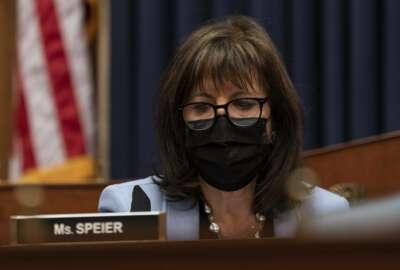
Agency watchdogs get together on the issue that affects everyone, diversity and inclusion
A new working group has arisen at the Council of the Inspectors General on Integrity and Efficiency, the collective of all the federal IGs.
Best listening experience is on Chrome, Firefox or Safari. Subscribe to Federal Drive’s daily audio interviews on Apple Podcasts or PodcastOne.
A new working group has arisen at the Council of the Inspectors General on Integrity and Efficiency, the collective of all the federal IG’s. The new Diversity, Equity and Inclusion Work Group aims to make sure the IG offices’ workforces are sufficiently diverse. With what the work group will do and how it will operate, Federal Drive with Tom Temin spoke with the acting inspector general of the Education Department Sandra Bruce and Federal Deposit Insurance Corporation IG Jay Lerner.
Interview transcript:
Tom Temin: We’ve got the acting Inspector General of the Education Department, Sandra Bruce. Ms. Bruce, good. to have you on.
Sandra Bruce: Good to be here, Tom. Thank you.
Tom Temin: And Federal Deposit Insurance Corporation IG Jay Lerner. Mr. Lerner, good to have you on.
Jay Lerner: Great to be here, thank you.
Tom Temin: So my first question is, are you going to be looking at diversity, equity and inclusion at the offices that you respectively have in CIGIE or is this something that you’re going to look at as IGs across the agencies that you have some degree of oversight for?
Sandra Bruce: Actually Tom, it’s all of the above. It’s very important for us as a community to promote diversity, equity, inclusion throughout the community. So to do it as a member of CIGIE, or a CIGIE body and respective IGs, that will be the only and best way that we could do that. It’s really important to make sure that we have an organizational culture where all the staff feel valued. They feel like they’re treated equitably. They’re able to freely express their perspectives, that kind of culture, it transcends to a high performing team. And it allows us to retain diverse talent, and to be innovative and have comprehensive work.
Tom Temin: Jay?
Jay Lerner: I completely agree with what Sandra said. It’s both internally looking inward within the community and external, meaning the oversight work and holding the agencies accountable within the government.
Tom Temin: And when I was growing up, the word was equal, everybody is equal under the law, everyone should be treated equally. And I’m trying to understand the meaning of the term equity, it seems to have replaced equality. And maybe you can help me know what that means in this context.
Sandra Bruce: Well, it’s interesting for us, Tom. Actually, the executive order on advancing racial equity and support for under served communities to the federal government, it clearly defined equity. Equity is the consistent and systemic fair, just an impartial treatment of all individuals, including individuals who belong to underserved communities, and have been denied such treatment. And that gets into the definition that you were talking about equality. We were used to hearing about race, ethnicity, age, gender, those are the legal requirements that we typically look at, right. But here we’re talking about the same demographics, but making sure that everyone has access to all, equitable access for all.
Jay Lerner: To add to that Tom, I think equity really is a matter of fairness and justice. And like Sandra said, impartial treatment. So I think of it in terms of opportunities and making sure everyone has opportunities to shine and to demonstrate their performance.
Tom Temin: Alright, all worthy goals. But now you have a work group within CIGIE. And how will the work group work? What will you do and how will you measure your output?
Sandra Bruce: So the workgroup… actually, I’ll do with the output first. Our ultimate goal is to develop a roadmap for diversity, equity inclusion. We have small, medium, and large ologies in the community. And we want everyone to be able to take this and kind of use it like a menu where we have specific focus areas. Some that Jay actually mentioned earlier, talking about the internally focused or the outwardly focused areas, and we’re actually developing strategies and actions, toolkits, videos, lists, references, indicators, and even metrics to help measure the progress of diversity, equity inclusion throughout the community. So that’s our ultimate goal. But then the way that we operate, we meet monthly and during those monthly meetings, we talk about — well, first, we make sure that we have an opportunity to enhance our own diversity, equity, inclusion and competence, right. We want to make sure that we’re clear and that we understand what that means. So we invite speakers and we’ll do videos, we even have discussions on something as simple as Heritage Month, what does it mean to us? And then during those monthly meetings, we also get the support groups to talk about the progress for the areas that they particularly have for the roadmap. So the roadmap is really our ultimate goal from making sure that we could get the word out to the community.
Jay Lerner: And Tom, there’s two other projects that I think are worth highlighting that the group is working on. The first is related to a survey within the IG community, going out to all members, all employees within the IG community to gain a better understanding of what’s going on among the 14,000 or so employees within the IG community. And that will set a baseline for a maturity model to measure progress over the course of time from year to year, how the IG community is doing and making progress. The second area is we’re collecting OIG reports that have been issued on various topics related to diversity, equity and inclusion in the principles they include, whether it’s law enforcement or policing or prison activities, or banking and finance, the area I work in, or Education, like Sandra’s area, or healthcare, collecting that information, those reports and we want to make sure we’re highlighting that on behalf of the IG community, and to be able to draw themes and patterns to understand what’s going on within the federal government and develop tools and techniques, ways to measure that within the federal government.
Tom Temin: And Sandra, I have a personal question for you, as a black woman who has come up through the ranks in the federal government and acting IG of Education Department is a pretty high level position. What’s been your personal experience with respect to diversity, inclusion, and kind of the hard to measure effects of how you feel you’ve been treated and mentored?
Sandra Bruce: I’m so glad you asked me that question, Tom. That’s part of the reason that when I was asked to be the chair for diversity, equity inclusion, I quickly accepted and was honored to do so. Diversity, equity, inclusion is a journey, not a destination. And for me, over the years, while I have experience, I’ll say the isms and the opportunities where people may not necessarily have understood my diverse perspective, that NSF also fueled me to make sure that I did try to keep an open mind and make sure I understand what people are saying, not to automatically go to the default, that is one of the isms that to understand that it is because of diverse perspectives that we all think differently. We speak differently, and we process differently. So with my experience, from high school to a secretary to sitting in this IG position, I’ve taken each opportunity that I’ve had, whether it was painful, I didn’t like it or what have you, to pretty much just fuel that into making sure that I keep an open mind, a good heart, and a great understanding about what people truly are trying to say and do, whether I understand it or not, or I like it, at least be able to respect it.
Tom Temin: I think that heart idea is a pretty good ingredient that’s missing in a lot of these talks sometimes. And Jay, let me ask you your experience, or do you have a baseline sense of how diverse in just in terms of the, I guess, racial makeup, the IG community is at this point? And maybe how it compares to the rest of the federal workforce or how it compares to some ideal?
Jay Lerner: Well, I think it varies from office to office. And as Sandra said, there are small, medium and large OIGs at the moment. I think we’re still gathering that information as part of the survey. But that is going to set the baseline not only in terms of race, but in terms of other protected classes and other trades and attributes that we’ll be measuring.
Tom Temin: And do you anticipate looking at the agencies that you our inspectors general have, that you’ll be looking to launch perhaps investigations or insights into their different components and their own D&I work?
Jay Lerner: Yes, I think that’ll be part of it. And it’s up to each individual inspector general to be able to make that determination. There’s already been some work done. And that’s what I was referring to collecting that information so that other IG offices can learn from those experiences and develop tools and techniques and ways to measure that situation.
Tom Temin: Sandra, final word?
Sandra Bruce: If you want to be an organization, have a place to incorporate diversity, equity inclusion and be committed about doing so.
Tom Temin: Sandra Bruce is acting Inspector General of the Education Department. Thanks so much for joining me.
Sandra Bruce: Thank you, Tom. Thanks for having us.
Tom Temin: Jay Lerner is the IG of the Federal Deposit Insurance Corporation. Thank you also.
Jay Lerner: Thank you and thank you for highlighting this work. It’s really important.
Copyright © 2025 Federal News Network. All rights reserved. This website is not intended for users located within the European Economic Area.
Tom Temin is host of the Federal Drive and has been providing insight on federal technology and management issues for more than 30 years.
Follow @tteminWFED




